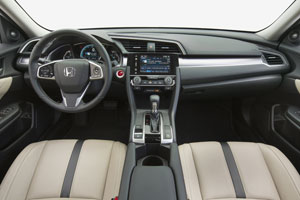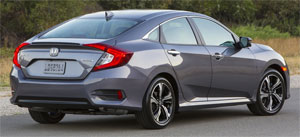2016 Honda Civic Sedan
Like the auto industry itself, it’s been quite a roller coaster of late for the Honda Civic. After its 2011 redesign was met with much disdain by professional car testers, it was hastily re-done just a year later. But, there was only so much they could do. It would take a full reengineering to return the Civic back to its accustomed pedestal. Well now it’s arrived, the 10th generation Honda Civic. So, let’s see if it still deserves its perch.
Redesigning the Honda Civic is surely a tightrope act that even the Flying Wallendas would think twice about. On one hand, people have extremely high expectations of what a Civic is and should be; and on the other hand people want to see lots of improvements that make upgrading worth it. And much like an extremely dangerous high wire act, getting it wrong would be a real disaster.
So, Honda’s goal for the 2016 Civic; like any stunt performer will tell you, is to do all of the prep work possible, leaving nothing to chance. For Honda, that means making it better in every possible way.
Starting it off, there’s some exciting news under the hood for a change, 2 new 4-cylinder engines. A 158-horsepower 2.0-liter, and a 174-horsepower 1.5-liter turbo that spins up 162 lb-ft. of torque.
 The tiny turbo is the more intriguing of the two, and the one we spent the most time with on our first drive opportunity just outside of New York City.
The tiny turbo is the more intriguing of the two, and the one we spent the most time with on our first drive opportunity just outside of New York City.
It’s a little bit laggy with power delivery, clearly feeling more entry level than sporty. But S mode tightens things up, though not so much that you can’t leave it in there all of the time, which we eventually did.
The CVT transmission attached to it does the best job yet of acting like a real automatic, unless you’re keeping it pinned for extended periods a la highway on ramps. And even then, it’s fairly quiet.
Government Fuel Economy Ratings aren’t official, but Honda puts the 1.5-liter at 31-City, 42-Highway, and 35-Combined. The 2.0-liter is remarkably similar at 31-City, 41-Highway, and 35-Combined with a CVT. A 6-speed manual is also available with the 2.0-liter.
Coupe and first time 5-door hatchback body styles will be available, but sales will start off with the bread and butter 4-door sedan.
It’s still highly recognizable, but the new Civic sedan has gotten a lot more stylish with a coupe flavored silhouette, exaggerated fenders, and very aggressive looking face with LED running lights.
 Wheelbase is 1.2-inches longer than before at 106.3; and overall length sees a gain of almost 3-inches. It also sits lower and wider.
Wheelbase is 1.2-inches longer than before at 106.3; and overall length sees a gain of almost 3-inches. It also sits lower and wider.
Of course that adds to interior space which now feels more mid-size than compact. There is plenty of room up front; with more than expected hip, leg, and head room in back, even when equipped with a sunroof. Trunk space also sees a big boost to 15.1 cubic-ft.
Seat comfort is very good and the low seating position is reminiscent of 80’s Japanese cars. Small A-pillars and a big windshield provides the typical Honda great visibility, aided by big side mirrors and a standard backup camera.
The dash is very linear looking without much to break up the flow. Both fit-and-finish and material quality are impressive. Thankfully the two tiered gauge experiment has come to an end.
Despite our turbocharged car’s lag time at launch, we were off to a decent 0-60 time of 7.5 seconds. With both the little turbo cranked and CVT screaming, the ¼-mile passed in a respectable 15.7-seconds at 93 miles-per-hour.
 Through the cones there is a noticeably firmer feel, and a lot less understeer than before. Throw on beefier tires with actual grip, and Honda might really have something here. The steering stiffens up as you go, but it’s a very artificial feel, not necessarily a helpful one.
Through the cones there is a noticeably firmer feel, and a lot less understeer than before. Throw on beefier tires with actual grip, and Honda might really have something here. The steering stiffens up as you go, but it’s a very artificial feel, not necessarily a helpful one.
Civic pricing is up slightly, but remains under 20G’s, with a base, well equipped LX Sedan starting at $19,475. Top Touring trim with the turbo and Honda Sensing accident avoidance package begins at $27,335.
Despite recent journalistic pans, the Civic has remained a compact car sales leader. Still, Honda took no chances this time around, and has updated everything possible in the 2016 Civic. Looks like the 10th time is a charm.
Specifications
- Engine: 1.5 liter turbo
- Horsepower: 174
- Torque: 162 lb-ft.
- 0-60 mph: 7.5 seconds
- 1/4 mile: 15.7 seconds @ 93 mph
- EPA: 31 mpg city/ 42 mpg highway,
2024 Polestar 2
More Range And More Power For The Polestar 2
Volvo is well on their way to making the transition to an all-electric brand, but their sister-brand Polestar is already there. Now, we’ve spent lots of time in their all-wheel drive, five-door Polestar 2, having tested it in 2021, and a year later when a two-wheel drive version arrived. But, EV updates are coming quickly. So, let us be your guide for all that’s new with the Polestar 2.
While we are driving more EVs than ever, we’ve also been spending a lot of time recently circling back to ones we’ve previously tested. As in this new era of electrified vehicles, significant updates are arriving quickly, with R&D investments increasing and retrofitting them easier than ever. This is often done through software updates that can even be accomplished over the air. For 2024, the Polestar 2 has indeed gotten some software updates, but some physical ones as well.
Clearly aimed directly at Tesla’s Model 3 when it arrived; the Polestar 2’s build quality was vastly better, but range definitely came up short. So, addressing that was priority No. 1; and for ’24 the Polestar can travel up to 20% farther than before while consuming 9% less energy, and when it comes time to charge it back up, it can do that 34% faster too.
Range in the Single Motor version increases from a max of 270 to 320 miles thanks to a larger 82-kWh battery pack, and that solitary motor now powers the rear wheels, not the front wheels. It’s also bigger, coming in at 220 kW compared to the previous 170 kW front-wheel drive version, going from 231 to 299 horsepower.
Dual Motors keep the same 78-kWh battery, but still sees a boost from 260 to 276 miles and takes advantage of the larger rear motor for a new combined 310-kW output with 421 horsepower. Our test car has the added Performance Pack, which uses an additional 35 kW to deliver 455 horsepower and 546 lb-ft of torque, though max range drops to just 247 miles.
The new battery in rear-drive 2s will also charge faster, now accepting up to 205 kW for an 80% charge in 20 minutes; max for dual-motors stays at 155 kW, which puts an 80% charge at 34 minutes. Using 32 kWh of electricity per 100 miles, the Dual Motor earns a good efficiency rating.
The [Polestar] 2 has always been one of the most enjoyable EVs to drive, even more so now with that additional power coming from the rear motor.
Unfortunately, extremely cold temperatures kept us from seeing that increased range, as we were only on pace for about 194 miles in our test.
The 2 has always been one of the most enjoyable EVs to drive, even more so now with that additional power coming from the rear motor. And especially when equipped with the Performance Pack as it not only includes more power, but adds 20-inch forged wheels, upgraded brakes, and adjustable Ohlins Dual Flow Valve performance dampers. It greatly improves handling prowess without affecting ride quality, and is easily worth the $5,500 charge if you at all enjoy driving.
Even on a 20-degree track day there was plenty of grip through our handling course. No understeer or oversteer, and lots of feedback through the wheel. There was a nice, strong launch off the line that properly planted us firmly in the seat, and rocketed us to 60 in 4.5 seconds. Power delivery stayed pretty intense up until about 80 mph when there was a definite tapering off. Still, it was a 13.4-second quarter-mile at 102 mph; smooth, quiet, and stable the whole way.
When this car debuted, its Google-based infotainment setup was a novelty, but since then, more and more manufacturers are just “Googling it” so it doesn’t seem out of place at all. The wireless phone charger is easy to access, and there’s a great Harmon/Kardon sound system and panoramic sunroof to enhance the in-cabin experience. Exteriors have also been enhanced with a smooth grille insert and new wheel choices.
Hatchback practicality means 14.3 cu-ft of easy to access cargo space with split-folding seatbacks for longer items and expanding the space to 38.7 cu-ft. Plus, there’s even a sizeable storage bin up front under the hood.
Single Motor Polestar 2 pricing now starts at $51,300, with Dual Motors starting at $56,700; topping out at $64,400.
For a car manufacturer that hasn’t even been around for a decade yet, Polestar has kept itself busy, totally transforming their latest model in just a few years, making the 2024 Polestar 2 even more appealing. They are certainly off to a good start, and with a host of Polestars just over the horizon, including some all-important utility vehicles, this star will be shining even brighter.
Specifications
As Tested
- Motor Setup: Dual Motor
- Horsepower: 455
- 0-60 mph: 4.5 seconds
- EPA Range: 247 miles
- Efficiency : 32 kWh / 100 miles
- Battery Size: 78-kWh
- Torque: 546 lb-ft
- 1/4 Mile: 13.4 seconds at 102 mph
- MW Test Loop: ~ 194 miles
- Peak Charging Rate: 155 kW











































